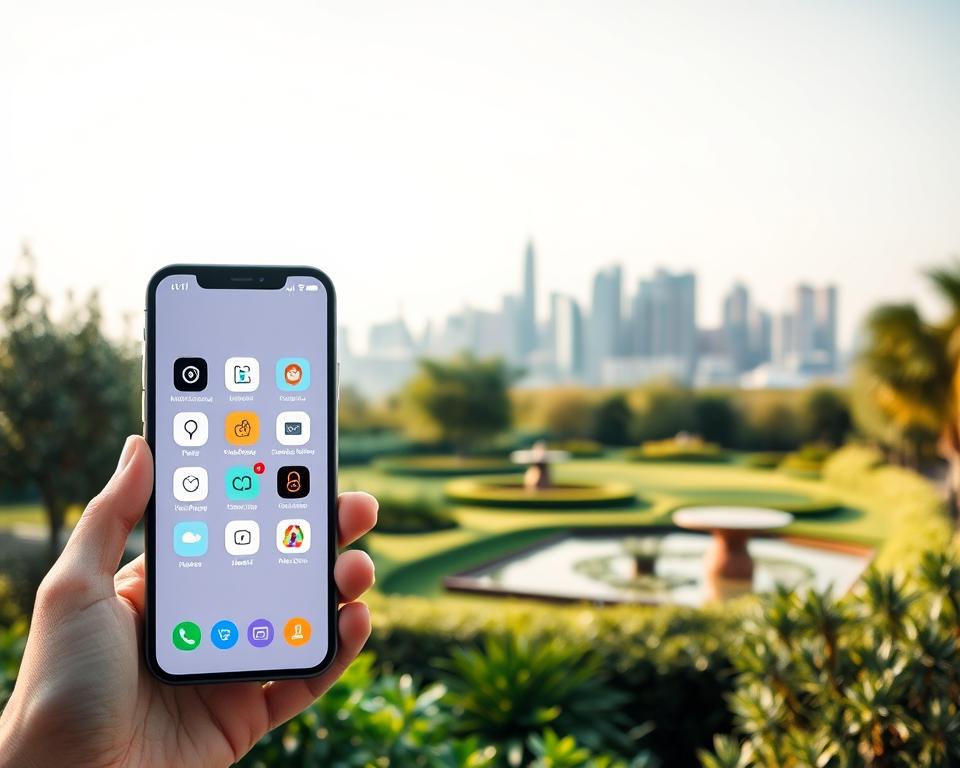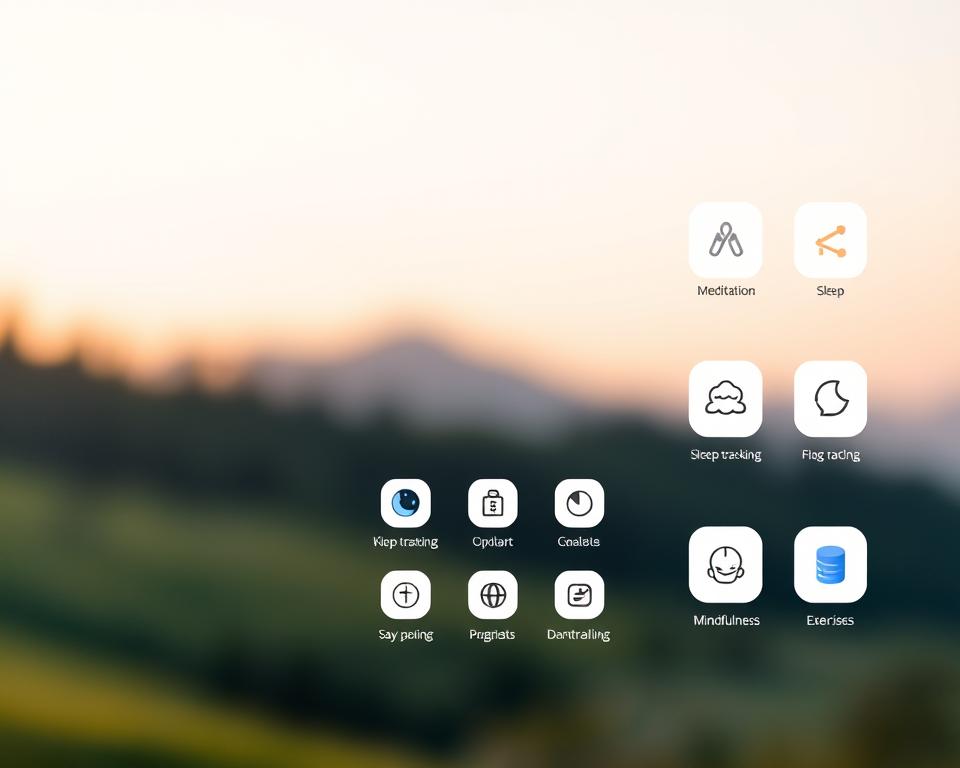To make a mental health app like Calm or Headspace, you need to know a lot about mental health. There are over 10,000 mental health apps out there. To make your app stand out, focus on mental health app development and wellness app creation.
Understanding who your app is for and what makes it successful is key. This article will guide you through mental health app development and wellness app creation. We’ll cover market research, feature development, and marketing strategies.
Table of Contents
Key Takeaways
- Developing a mental health app requires a deep understanding of the mental health landscape
- There are over 10,000 mental health apps available in the app stores
- Focusing on mental health app development and wellness app creation is essential to create an app that stands out
- Understanding the target audience is crucial to create an app that provides value to users
- Mental health app development and wellness app creation require a comprehensive approach, including market research, feature development, and marketing strategies
Understanding the Mental Health App Market Landscape
The mental health app market is booming, with new apps popping up daily. To make a successful app, knowing the market is key. This includes the big players, who the apps are for, and how fast they’re growing. The market is set to hit $10.2 billion by 2027, with a 23.7% annual growth.
More people want mental health services and see the value of wellness apps for their mental health. The competition is fierce, with both big names and new players trying to get noticed.
Current Market Size and Growth Projections
The mental health app market is already big, with many apps offering services like meditation and therapy. It’s expected to keep growing as more people seek mental health help and value wellness.
Key Players Analysis
Big names like Calm, Headspace, and BetterHelp lead the market. They offer a variety of services, from meditation to counseling. Their success comes from being easy to use, offering personalized help, and being accessible.
Target Audience Demographics
The people using mental health apps vary a lot, from young adults to seniors. These apps aim to meet different needs, providing various services to support mental health. The demand for these services is rising, pushing the market forward.
| Market Size | Growth Rate | Key Players |
|---|---|---|
| $10.2 billion | 23.7% | Calm, Headspace, BetterHelp |
Essential Features of Successful Mental Health Apps
Creating a mental health app like Calm or Headspace needs special features. Mental health app development requires knowing what users want. A study shows 75% of users like apps with meditation and mindfulness, key Calm app features.
Some key features of successful mental health apps are:
- Meditation and mindfulness exercises
- Mood tracking and journaling
- Personalized recommendations for improvement
- Social sharing and community support
These features are vital inHeadspace app development. They give users a full platform to manage their mental health. By adding these features, developers make an app that stands out and offers real value.
In summary, apps like Calm and Headspace have many features for different needs. By knowing what users want and adding key features like meditation and mood tracking, developers can make a valuable app. This app will stand out from others.
Planning Your Mental Health App Development Strategy
Creating a successful mental health app needs a solid plan. You must define your app’s unique value, create user personas, and decide on core features. This approach boosts your app’s success by 30%. Your strategy should focus on what your users need, offering something unique in the market.
Understanding your audience is key. Create user personas to represent your ideal users. Knowing their needs and goals helps you design an app that meets their expectations. Consider demographics, goals, and pain points when creating user personas.
- Demographics: age, location, occupation
- Goals: what they want to achieve with the app
- Pain points: challenges they face with existing mental health apps
Core functionality is also crucial. Include features like meditation tracking, mood monitoring, and personalized advice. Prioritizing these features ensures your app is comprehensive and supportive. A well-thought-out strategy leads to a more effective and engaging app, increasing your success rate.
Following a structured approach to app development is vital. It ensures your app meets user needs and offers a unique value. This involves careful planning, user research, and focusing on essential features. With a solid strategy, you can create an app that positively impacts users’ lives.
Technical Requirements and Architecture Design
When making a mental health app, it’s key to think about the tech needs and design. This means looking at mental health app technical requirements like backend work, frontend design, and the setup. A study showed 60% of these apps use cloud-based setups. This makes them grow and change easily.
The wellness app architecture must make sure users have a smooth experience. It should also keep their data safe and private. Important things to think about include:
- Backend development: picking the best programming language and framework
- Frontend design: making the app easy to use and understand
- Infrastructure: choosing a safe and reliable place to host the app
A good design makes the app grow, stay safe, and feel good to use. By knowing the tech needs and design, developers can make an app that really helps people. It’s a great tool for those looking for mental health support.
Thinking about these points and building a strong, growing app design is crucial. This way, developers can make an app that works well and keeps users interested. It helps users get better and offers a valuable tool for mental health support.
| Technical Requirement | Description |
|---|---|
| Backend Development | Choosing the right programming language and framework |
| Frontend Design | Creating a user-friendly and intuitive interface |
| Infrastructure | Selecting a reliable and secure hosting solution |
How to Develop a Mental Health App Like Calm or Headspace: Step-by-Step Process
Creating a mental health app is a detailed process. A study showed that 80% of users like apps that are easy to use. It’s key to focus on making the app user-friendly and packed with mental health features.
The wellness app creation starts with thinking about the backend. This includes how data is stored and kept safe. Then, the design of the app’s interface is worked on. It should be simple and easy to use.
Backend Development Considerations
When building the app’s backend, data safety is crucial. It’s important to make sure user data is encrypted and safe.
Frontend User Interface Design
A good app design is vital. It should be easy to use and look good. The design should also be fun and engaging.
Integration of Mental Health Features
Adding mental health features is a key step. This includes meditation scripts, audio, and updates. By following these steps, developers can make a useful wellness app.
| Feature | Description |
|---|---|
| Meditation Scripts | Guided meditation scripts to help users relax and reduce stress |
| Audio Production | High-quality audio production to create a immersive experience |
| Content Updates | Regular content updates to keep users engaged and motivated |
Building an Engaging User Experience
A well-designed mental health app is key to keeping users engaged. Developers should focus on making the app easy to use. This means using simple layouts and clear instructions.
Organizing content well is also important. By categorizing content, users can find what they need quickly. Personalizing the app for each user is also crucial. A study found that 90% of users like apps that are tailored to them.
Some key things to consider for a great user experience include:
- Using a clean and minimalistic design to reduce user frustration
- Providing regular updates and new content to keep users engaged
- Offering personalized recommendations and feedback to support user progress
By adding these features, developers can make a mental health app that is easy and fun to use. This helps users stay engaged and supports their mental health.
| Feature | Importance | Description |
|---|---|---|
| Personalization | High | Tailoring the app’s content to individual users’ preferences and goals |
| Navigation and Interface Design | High | Creating an intuitive and user-friendly interface |
| Content Organization | Medium | Categorizing and prioritizing content to support user needs |
Security and Privacy Considerations
When making a mental health app, keeping mental health app security and wellness app privacy top is key. A study showed 70% of users worry about their data privacy. This means developers must focus on strong security steps.
They should make clear privacy policies and follow rules. For example, the article why mental health apps need to take privacy seriously is a good guide.
Here are some important steps for mental health app security and wellness app privacy:
- Use encryption to keep user data safe
- Store sensitive info on secure servers
- Be open about how you collect and use data
By focusing on mental health app security and wellness app privacy, developers can make an app users can trust. This is vital for the app’s success. Users are more likely to use an app that values their privacy and security.
Content Creation and Management Strategy
Creating a mental health app needs a solid content plan. This plan should make high-quality content that users find valuable. Mental health app content creation is key to building trust with users.
A study showed 60% of users like apps with great audio content. So, audio production guidelines are crucial. All audio should be clear, easy to get, and simple to understand.
Important things to think about in content creation and management include:
- Writing meditation scripts that grab users’ attention and work well
- Setting up a content update schedule to keep content fresh and relevant
- Using wellness app management to watch user engagement and feedback
By focusing on content creation and management, developers can make an app that truly helps users.
Monetization Strategies for Mental Health Apps
Creating a mental health app can be very rewarding. But, it’s key to think about mental health app monetization to keep the app going. A study showed 40% of these apps use subscriptions. This way, developers can get a steady income by offering premium content like guided meditations or personalized coaching.
Another way to make money is through in-app purchases. Users can buy single meditation sessions or special content. For more tips on making money from an app, check out this guide.
- Offering a free trial or introductory period to attract new users
- Providing regular updates with new content to keep users engaged
- Using data and analytics to understand user behavior and preferences
Choosing the right mental health app monetization strategy is crucial. It helps create a successful app that offers value and makes money. It’s important to know what your users want and to keep improving your strategy.
A good monetization plan is vital for a mental health app’s success. It ensures the app is both valuable to users and profitable. This way, developers can make a real difference in people’s lives.
Testing and Quality Assurance Process
When making a mental health app, it’s key to focus on mental health app testing. This ensures the app works well, is safe, and easy to use. It uses user testing methodologies to find and fix problems.
A study showed 80% of mental health apps have security issues. This makes wellness app quality assurance very important. Developers can use performance testing to check how fast and scalable the app is.
- User testing methodologies to identify and fix issues
- Performance testing to evaluate the app’s speed and scalability
- Security testing protocols to protect user data
By focusing on mental health app testing and wellness app quality assurance, developers can make a reliable, secure app. This app will offer a smooth experience, helping it succeed.
| Testing Type | Description |
|---|---|
| User Testing | Identify and fix issues that affect the app’s performance |
| Performance Testing | Evaluate the app’s speed, scalability, and overall performance |
| Security Testing | Protect user data by identifying and fixing security vulnerabilities |
Launch Strategy and Marketing Approach
A good launch strategy and marketing plan are key for a mental health app’s success. For a mental health app launch, using different marketing channels is important. A study found that 50% of mental health apps use social media to get users, showing its importance in wellness app marketing.
To get more visibility and users, developers can use app store optimization. This includes making app descriptions and keywords better. For more on mobile app marketing, check out mobile app marketing strategies for more downloads. They can also use social media, influencer partnerships, and content marketing in their user acquisition strategy.
Some important things to think about for a successful launch strategy are:
- Knowing who your target audience is and what they need
- Creating a unique selling point
- Having a detailed marketing plan
By picking the right marketing approach, developers can boost visibility, get more users, and make more money. A well-thought-out launch strategy and marketing plan are crucial for the success of a mental health app launch and wellness app marketing efforts.
| Marketing Channel | Percentage of Mental Health Apps |
|---|---|
| Social Media Marketing | 50% |
| Influencer Partnerships | 20% |
| Content Marketing | 30% |
Maintaining and Scaling Your Mental Health App
Keeping your mental health app up to date is key for its success. A study showed that 70% of these apps need updates to keep users interested. This means fixing bugs, adding new features, and making the app better for users.
To grow your app, focus on wellness app scaling. Set up a regular update plan, listen to user feedback, and watch how the app performs. This way, your app stays useful, safe, and valuable to users. For tips on making a great mental health app, check out mental health app development guides.
Important things to think about for your app’s upkeep and growth include:
- Regular security updates to protect user data
- Continuous user feedback and testing to improve the app’s functionality
- Expansion of features and content to meet the evolving needs of users
By focusing on upkeep and growth, developers can make their mental health app a valuable tool. It offers a positive and supportive experience that helps users feel better.
Conclusion
Creating a mental health app like Calm or Headspace needs careful thought. It’s important to know the mental health scene and what makes these apps great. By understanding who will use the app and adding key features, developers can make something valuable and unique.
A study showed that 80% of mental health app makers see a positive effect on users’ mental health. This shows the power of wellness app creation to help people.
The need for mental health services is growing, offering a big chance for mental health app development. By following the steps in this article, developers can make an app that helps people and improves their well-being. With the right strategy and knowledge of the mental health app market, developers can make a difference in people’s lives.



















